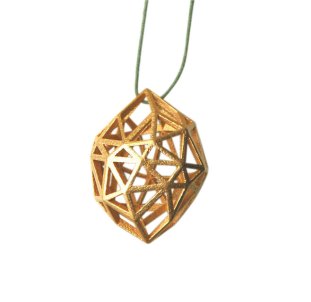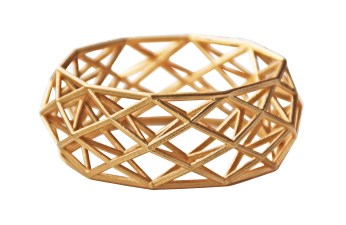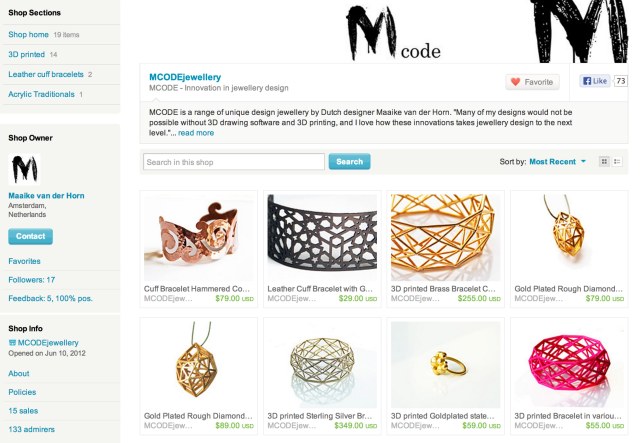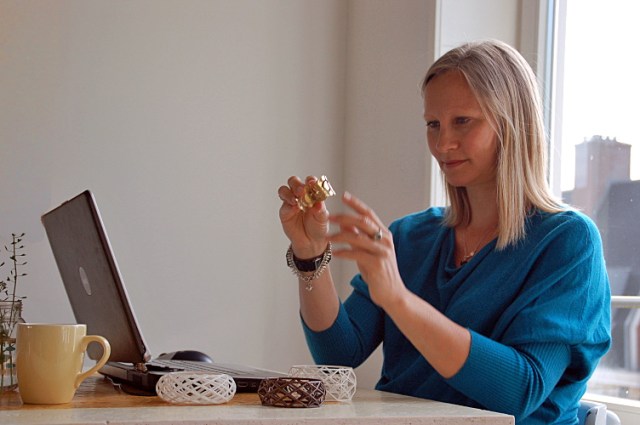Although 3D printing technology has existed for some time, it's only now beginning to cross over into mainstream awareness, thanks to increasingly affordable access to the printers themselves, as well as attention-grabbing headlines about 3D printed guns and life-saving medical applications. While less eye-catching, perhaps, the innovation is also powering a new class of creatives, who are using 3D printers to produce art instead. Their "handmade" goods, including jewelry, home decor, gifts and more, appear on sites like the marketplace for crafters, Etsy, and the 3D printing resource center and online shop, Shapeways.
These modern-day artists don't always fit the traditional mold – or stereotype, rather – of what an artist should be. They don't necessarily have a studio or workshop, nor do they always have an art background or related experience. Sometimes, they're drawn in because of the technology and science involved, only then discovering their more artistic side.
And sometimes, they're just everyday people working day jobs in unrelated fields who have discovered 3D printing as a new way to express themselves creatively, communicating their visions and ideas to a wider audience than they had ever thought possible.
These are their stories.
This is part two of an ongoing series which will showcase some of the art that's being fueled by the ever more accessible 3D printing technology, and the artists behind the work. In part one, we profiled a formally trained artist who was inspired to use 3D printing for her work, after first coming across the technology years ago.
~~~~
Part Two: The Self-Taught Learner
When Dutch designer Maaike van der Horn wanted to learn how to use 3D modeling software, she turned to YouTube. The site, she says, is filled with several tutorials that walk you through the basics, and sometimes she would watch these over and over while trying to find her way.
"If you have an idea in your head, and you spend a little bit of time – well, a lot of time, actually – you can actually get pretty far," she says with a chuckle.
 Van der Horn currently works as a market researcher for a European airline, but over the past couple of years she had been trying to learn something entirely different: she wanted to be a goldsmith.
Van der Horn currently works as a market researcher for a European airline, but over the past couple of years she had been trying to learn something entirely different: she wanted to be a goldsmith.
Hoping to make a career change, van der Horn has been training part-time at a school for goldsmiths in the Netherlands in order to learn the trade.
"But I got frustrated because I had all these ideas in my head about things I wanted to make, but I realized that with the traditional goldsmithing techniques and practices, I wouldn't be able to make those, or would only be able to make those after 20 years of experience, maybe," she says.
Even if she became an expert in goldsmithing, the soldering and welding techniques wouldn't have allowed her to make some of the jewelry that's she's able to make today using 3D printing, and whatever she had ended up producing because of those limitations wouldn't have been her original vision — only some watered-down version instead.
"You wouldn't be able to make such complex and very geometric objects," she explains. "You wouldn't be able to be so precise."
3D printing offered a better alternative.
 Van der Horn first heard about the technology after spotting an article in her local newspaper, which talked about the website Shapeways – a site offering printing services as well as tools and help to guide those who are new to using the technology, and which just closed on $30 million in Series C funding in a round led by Andreessen Horowitz. The website soon became a valuable source of information for van der Horn.
Van der Horn first heard about the technology after spotting an article in her local newspaper, which talked about the website Shapeways – a site offering printing services as well as tools and help to guide those who are new to using the technology, and which just closed on $30 million in Series C funding in a round led by Andreessen Horowitz. The website soon became a valuable source of information for van der Horn.
She then began teaching herself how to use free software like SketchUp and Blender - a feat that's even more impressive considering that she never had formal training, nor does she have any sort of technical background that would lend her to being able to quickly pick up and adapt to new software programs. In college, in fact, she had studied Psychology, and even at her day job, she only uses basic Office software.
But YouTube tutorials and 3D modelers' forums have gotten her a long way. Once, when she really got stuck, she hired a fellow modeler to help, paying him $50 to solve a particular problem.
Van der Horn heaps praise on Shapeways, saying that the site made it so easy for her to learn and the prices for materials and printing costs were affordable. Although her initial efforts were a bit rocky – her first printed object was a 2D item – she's now able to produce interesting, unique and complex shapes.
Although she's always been crafty – van der Horn has filled her house with homemade furniture – her real love has always been jewelry. So that's what she's making today via Shapeways, where she tends to prefer working with metals. Stainless steel powder, printed, then fixated by being placed in a gold bath or bronze bath becomes modern, wearable jewelry like rings, earrings, necklaces and bracelets.
"It really stays close to the essence of what I'm trying to do. But I love gold and silver, and right now it's not possible to directly print in silver or gold at Shapeways," van der Horn explains. So sometimes, she prints the jewelry in plastic, then has it cast locally. "It's a mix of traditional techniques (the casting), plus modern techniques (the printing of plastic models). It's interesting to explore how those two worlds can mix together," she adds.
Today, most of her jewelry designing is done from the kitchen table or couch, from a beat up old laptop she wants to replace soon. In comparison, her goldsmith training takes place in a joint workshop where several artists pay to share the tools and equipment and split the cost of any repairs.
~~~~
Does 3D Art Have A Soul?
Like many of the early 3D artists, van der Horn's jewelry reflects its technical underpinnings with geometric shapes and sharp lines. In time, as people become more familiar with the techniques, that might change. Meanwhile, though van der Horn has always been drawn to geometric shapes herself, she's still trying to make sure her customers see that her jewelry is coming from her – an artist – not a machine.
"Many people place a lot of value on something that's handmade and has a direct connection to the artist. The challenge is to show that I put a little bit of myself into my designs," van der Horn explains. "You can do that by making things that are not so geometrical, or making every branch just off of where it should be. And maybe you can convey a sense that something comes from the heart of the artist," she says.
Now her shop is around a year old, and she sells her items both online and in local markets in Amsterdam. These days, she ships around 30 or 40 items per month, though that differs depending on the fairs and markets she attends.
Given the recent interest (some may even claim hype) around 3D printing, we asked van der Horn whether or not she thought the technology could produce items of long-lasting value, the way that her goldsmithing skills may do.
"It's more than hype," van der Horn asserts. "I do like to think we're at the beginning of development and we're only just exploring what anyone – people like you or me – can do with those techniques. For me, it feels like the new industrial revolution. Before, we were all more or less dependent on factories or multinationals who had production capabilities."
"Now," she adds, "production methods are opening up to anyone."



No hay comentarios:
Publicar un comentario